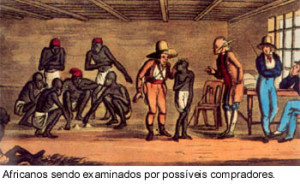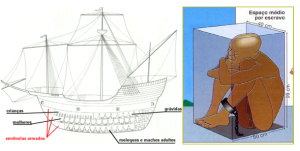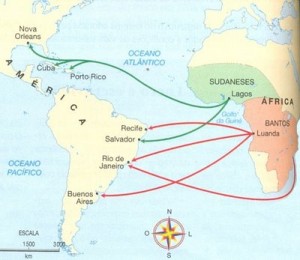
The word « slave » refers to a person submitted to a perpetual thrall. Considered as an animal, condemned to hard labour, he is a merchandize, a good which can be sold and sold again, its owner having the power of life or death on him.
« Slave trade is a business and a deal in which human being is treated like a good, a merchandize which doesn’t mean anything ».

Slaves sold on Congo’s coasts were mainly war prisoners. A reality imposed by local chiefs and traffickers. It was an exchange aiming to get Europeans products, such as weapons, alcohol or materials.
Considered as merchandize, men, women and children were caught. As a punishment, they had to stand many bad treatments. A real manhunt was settled up, from inlands to the kingdom’s littoral; slaves were transported and sold, ignoring their final destination.

In harbours, the biggest amount of human load was packed into warehouses where slaves spent one night or two, crying and without a single hope. There were forced to accept the fact they were going to leave definitely their homeland (Nsi Kongo). They were doomed to a lethal and scaring agony, through the immensity of the Atlantic Ocean. Completely naked, slaves only had a small material at belt height, to dissimulate their sex.
On the way towards the ships, prisoners were mistreated by traffickers. The slowest ones received violent strokes.

Those who walked ahead had their arms cut, to avoid any resistance, which accelerated the caravan’s pace. The groups or three or four slaves were led by twelve traffickers. Leading the walk, there were five or six men, who pulled the prisoners as if they were just animals. In order to prevent them from escaping, they were tied between themselves with a rope around the neck and a stick. The wooden stick was passing around the slave’s neck and determined his waist’s width. Bigger was the gap between the two forks, more resistant was considered the slave.
The fork was pierced of two holes down the back of the neck, which made the throat heavier and linked it to the heels by a metallic stalk. In those conditions, the walk’s security was guaranteed. The leading guy was able to control all the prisoners, strangling them or making them fall with a simple movement of the head or shoulders.

Captains looked for the best way to bring the fork’s arms to the heels, preventing the slightest opportunity to escape. Most of slaves did not even resist, their lives were left to chance and fate. Chains were removed only at the end of the trip.

The walk stopped at night. The iron chains were fixed to trees or anything else solid enough. The most vigorous slaves had their arms tied by thin ropes. Some prisoners desperately struggled for their freedom and managed sometimes to flee the merchants. Cabinda, Benguela, Luanda, Kuba and Lunda’ harbours were at the time the different places of human traffic. Travels were extremely long, on huge distances and the transportation conditions were inhuman.
 Slaves were boarded by force. Before boarding, slaves arrived on the coast in a terrible condition, completely exhausted by the walk imposed by the men hunters. During that period, there were many “Manis” (salves sellers) who sold slaves to Spanish, Portuguese, British, Deutsch and French people.
Slaves were boarded by force. Before boarding, slaves arrived on the coast in a terrible condition, completely exhausted by the walk imposed by the men hunters. During that period, there were many “Manis” (salves sellers) who sold slaves to Spanish, Portuguese, British, Deutsch and French people.

The slave trade, initiated by traffickers, has been an unspeakable calamity for the Congo’s slaves exported to Americas. Once the slave had been bought at the market, his body was marked forever with white-hot iron. During the trip across the Atlantic Ocean, inside the traffickers’ ships, all the slaves of the same family, tribe or the ones who were friends, were separated to avoid rebellions.
During the trip across the Atlantic Ocean, inside the traffickers’ ships, all the slaves of the same family, tribe or the ones who were friends, were separated to avoid rebellions.

In the ships, all the slaves were
strangers, with no right to communicate with each other and not knowing the others’ languages. Men were confined in the basement while women were at the second floor, pregnant ones in a room close to the stern. Children were at the first floor, packed like animals, surrounded by unbearable heat and bad smells.






